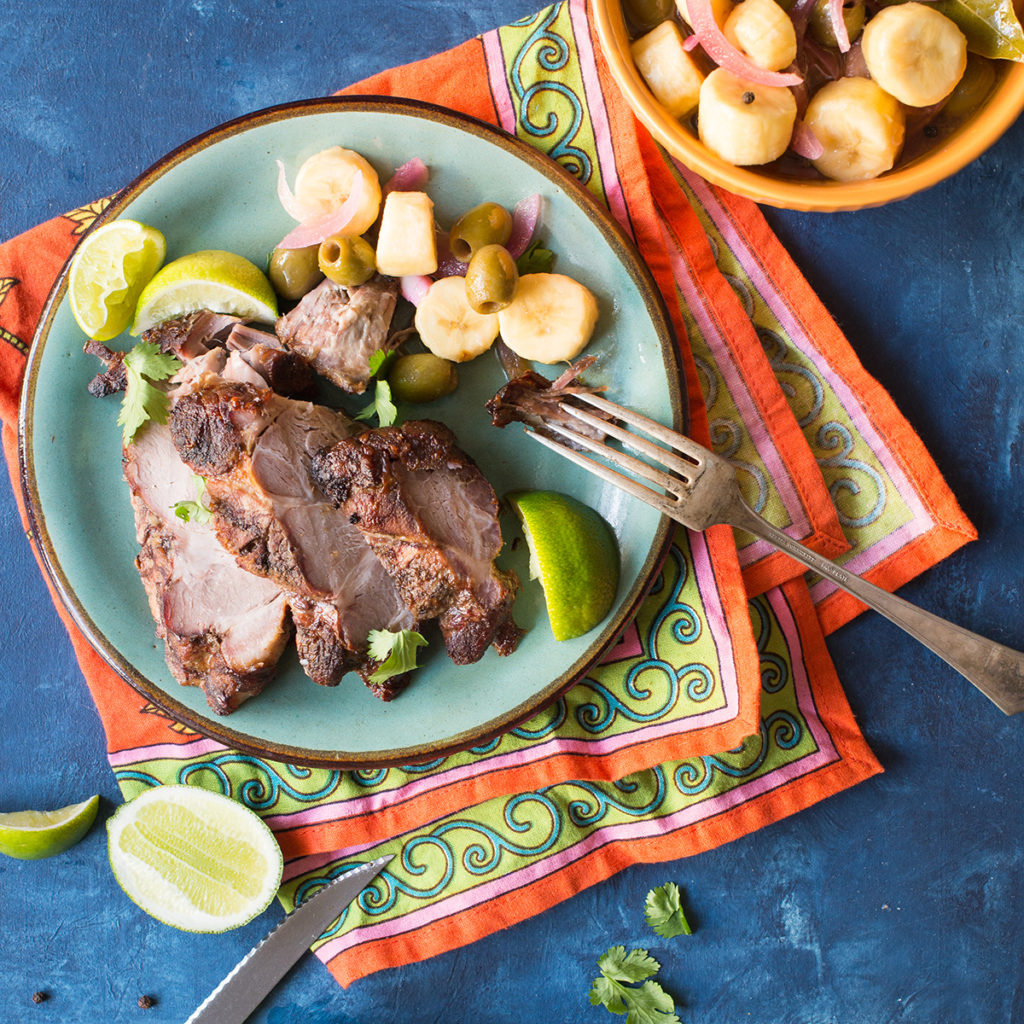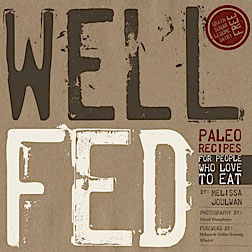I can hold two conflicting thoughts with equal conviction, and I have no problem with that whatsoever. For example: I generally like people who are...
Read MorePuerto Rican Roast Pork (Pernil Asado) & Pickled Bananas
In each issue of Paleo Magazine, I team up with Steph Gaudreau to bring you the story of a traditional recipe and adapt it to fit into a healthier Paleo lifestyle. (I make the food; she makes the gorgeous photos.) In this installment, it was a trip to Puerto Rico—the island of enchantment—for a pork shoulder and surprising pickles that will knock your socks off (which is great because no one wears socks on the beach).
Puerto Rico is known as the “island of enchantment”—la isla del encanto in Spanish. The small, square-ish island encompasses dramatic geography: rugged interior mountains surrounded by lush rainforest, powdered-sugar beaches along the coast, and the magical, mystical karst country in the north, with fantastical landscapes created by sinkholes, caves, underwater rivers, cliffs, and mogotes, its unique dome-shaped limestone hills.
And the weather? It’s balmy perfection: bright and humid with temperatures hovering between 76F and 88F year-round. But it’s not always sunny in paradise, and Puerto Rico is also subject to dangerous hurricanes and rain that falls like sheets. It’s estimated that the island will be hit by a major hurricane every 30 years. Sadly, on September 20, 2017, Hurricane Maria—a Category 4 hurricane with 150 mph winds—arrived in Puerto Rico with catastrophic results. Most of the island’s inhabitants were left without electrical power for months and the rebuilding effort will last for years.
We believe that one of the best ways to honor people is by making an effort to understand their culture: the role that art, music, customs, and food plays in everyday life. So, we’re sharing these recipes with you as a celebration of Puerto Rico: its resilient people, its breathtaking beauty, its place in history—both ancient and recent—and it’s life-affirming culinary traditions.
The island’s original inhabitants were the Taíno people, but in 1493, Christopher Columbus claimed Puerto Rico for Spain. Over the centuries, potential European invaders—the French, Dutch, and British—contributed their influence to the cuisine, as did West African slaves and the Spanish settlers. In 1898, after the Spanish-American War, Puerto Rico became a territory of the United States under the terms of the Treaty of Paris.
The food of Puerto Rico is known cocina criolla. (Creole cooking—not to be confused with the creole tradition of Louisiana.) Cocina criolla has its roots in the cooking of the original Taínos who built their meals around the food of the island: corn, tropical fruits, and seafood. The Spanish settlers brought black pepper, basil, cilantro, onions, garlic, beef, pork, lamb, goat, wheat, rice, and dairy to the island. Later, when the Europeans started the sugarcane industry there, the slaves they imported to work the plantations brought their food traditions, too: coconuts, coffee, okra, tamarind, yams, root vegetables, and the technique for deep-frying. Thanks to trade with Latin America, the local cuisine also adopted avocado, tomato, bell peppers, vanilla, and cocoa.
Now, the “modern” Puerto Rican cuisine is full of salty-fatty-crispy meats, starchy vegetables, and plenty of deep-fried things, all contrasted with citrusy, bright notes of fruits and pickles. The recipes we’ve chosen represent iconic island food: luscious, fall-apart pork balanced with the acidic flavor—and tender texture—of pickled green bananas. Don’t be put off by the unusual notion of pickling the bananas! The mouth-feel and flavor are similar to potatoes, and they’re the a surprisingly delicious contrast to the pork.

Puerto Rican Roast Pork (Pernil Asado)
Serves 8 | Prep 10 minutes | Marinate 6 hours | Roast 4 hours | Whole30 compliant
Ingredients:
1/2 cup fresh orange juice
1/4 cup red wine vinegar
1 tablespoon coconut sugar or honey (omit for Whole30)
1 tablespoon ground cumin
1 tablespoon salt
1 teaspoon ground black pepper
2 teaspoons dried oregano
10 cloves garlic
1 (4-lb.) boneless pork shoulder
Directions:
In a blender or the bowl of a food processor, combine the orange juice, vinegar, sugar, cumin, salt, pepper, oregano, and garlic. Process until the garlic is finely chopped, then set the marinade aside. Use a paring knife to cut 1-inch-wide slits all over the pork. Place it in a roasting pan and pour the marinade over the meat, rolling it to coat every surface. Marinate in the the fridge, turning the pork every few hours, for at least 6 hours (or overnight).
Preheat the oven to 425F.
Roast the pork for 20 minutes, then reduce the heat to 325F and continue to cook until an instant-read thermometer inserted into the shoulder reads 185F, about 4 hours. If you’re motivated, you can baste the pork with leftover marinade every once in a while. Remove the pork from the oven and let stand until it’s cool enough to handle, about 30 minutes. Break the pork into chunks and serve with pickled green bananas, lime wedges, and cilantro.
Pickled Green Bananas (Guineos en Escabeche)
Serves 8 | Prep 20 minutes | Whole30 compliant
Ingredients:
2 large green bananas, peeled and cut into 1-inch chunks
1/2 cup white wine vinegar
2 tablespoons extra-virgin olive oil
2 teaspoons salt
7 whole black peppercorns
3 cloves garlic, peeled and cut into quarters
1 small red onion, thinly sliced
1 bay leaf
1/2 cup pitted green olives
juice from 1/2 fresh lime
Directions:
Bring a large pot of water to a boil, add the bananas, and simmer until they’re just tender, about 7-10 minutes.
While the bananas cook, combine the oil, vinegar, salt, peppercorns, garlic, onion, and bay leaf in a saucepan over medium-high heat and cook until the onions and garlic are soft, about 5-7 minutes. Remove the pickling liquid from the heat.
Drain the bananas and place in large bowl with the olives and lime juice. Pour the pickling liquid over the top, toss gently with a rubber scraper to combine, and transfer to a pint-size mason jar. Gently tamp down the bananas so they’re submerged in the liquid. Cover and chill overnight to allow the flavors to meld. They should be stored in the fridge, but bring them to room temperature before eating.
Note: If you can’t find green bananas or prefer something more familiar, you can replace the bananas with 2 medium white potatoes.
Still hungry? Try these
For me, watching America's Test Kitchen and reading Cook's Illustrated are similar to flipping through a copy of Vogue and drooling over the fashions: I...
Read More




Hi, I found your blog while researching Amy Myers products, I am starting one of her online classes about autoimmunity. I’ve had autoimmune issues almost thirty years. I read some of your posts when you went to her. Do you think the time you spent with her was worthwhile?
I didn’t do her autoimmune classes, so I can’t speak directly to that, but she was my doctor to treat my hypothyroidism from 2012 until 2018 when she closed her in-person practice in Austin. I felt terrible when I first went to see her, and she worked with me to get the dosage of my thyroid hormones right. I’ve been feeling GREAT since about 2013 and it’s because she kept tinkering with my meds and listened to me when I told her how I was feeling. When I first went to see her, I did follow her eating protocol for 8 weeks, but I don’t have autoimmune issues, so regular paleo works fine for me. Hope this helps. Good luck to you!
Can Plantains be used in place of green bananas?
I haven’t tried it with plantains, but it should work. Make sure they’re very green, or they’ll be too soft and sweet for pickling. Let me know how they turn out, if you try it. They’re starchier than regular bananas, but the flavor should be the same.
Can’t wait to make this!
The green Olive reference in the pickled bananas … Where do they come into play,?
They’re in the pickled bananas… Step 3 “Drain the bananas and place in large bowl with the olives and lime juice.” Enjoy!